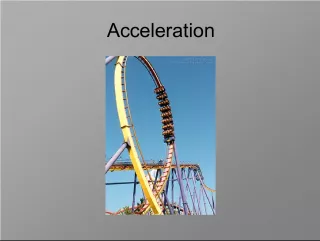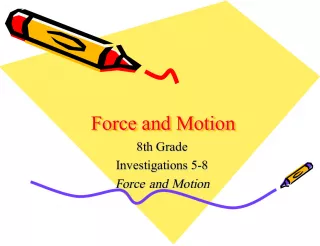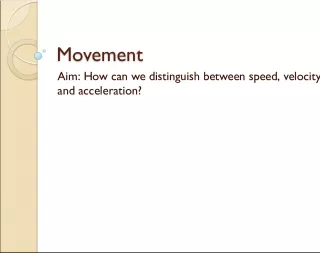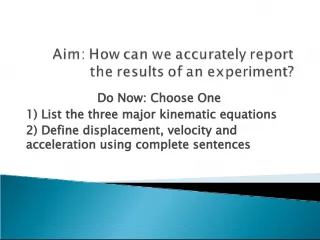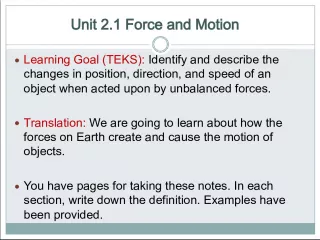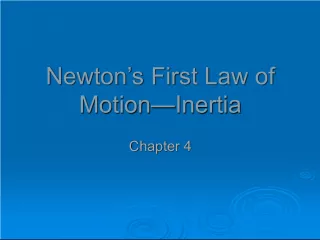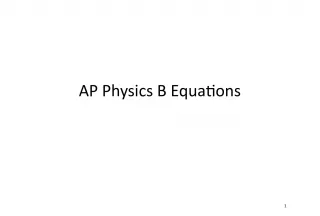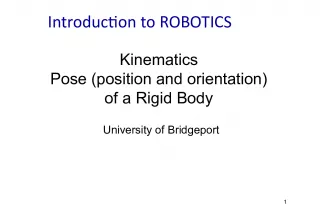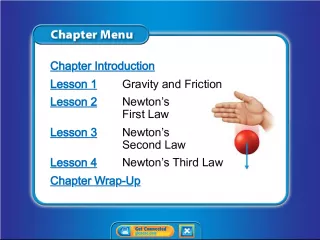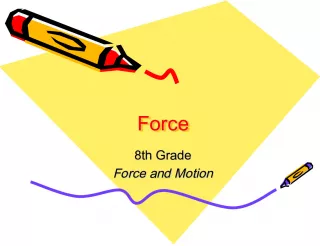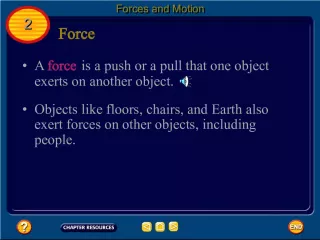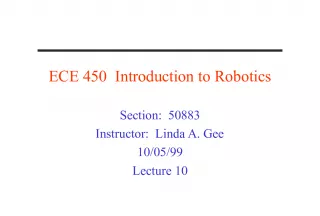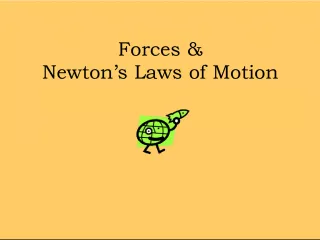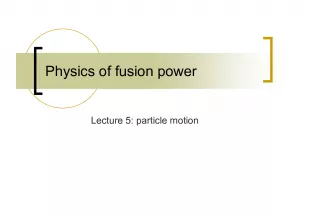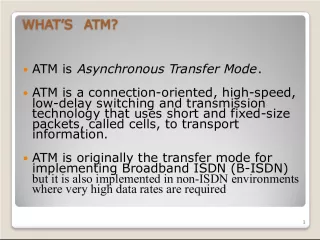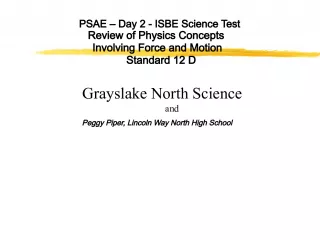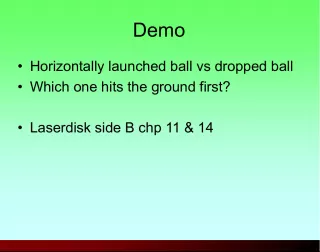Understanding Kinematics: Motion, Speed, Velocity, and Acceleration


This article explains the basic concepts of kinematics, including motion in one dimension, average speed and velocity, and average acceleration. Learn how to calculate these values and how to determine direction based on sign.
- Uploaded on | 0 Views
-
 ebin
ebin
About Understanding Kinematics: Motion, Speed, Velocity, and Acceleration
PowerPoint presentation about 'Understanding Kinematics: Motion, Speed, Velocity, and Acceleration'. This presentation describes the topic on This article explains the basic concepts of kinematics, including motion in one dimension, average speed and velocity, and average acceleration. Learn how to calculate these values and how to determine direction based on sign.. The key topics included in this slideshow are kinematics, motion, speed, velocity, acceleration,. Download this presentation absolutely free.
Presentation Transcript
1. Kinematics Notes Motion in 1 Dimension
2. Average Speed and Average Velocity Average speed describes how fast a particle is moving. It is calculated by: Average velocity describes how fast the displacement is changing with respect to time: always positive sign gives direction
3. Average Acceleration Average acceleration describes how fast the velocity is changing with respect to time. The equation is: sign determines direction
4. Sample problem: A motorist drives north at 20 m/s for 20 km and then continues north at 30 m/s for another 20 km. What is his average velocity?
5. Sample problem: It takes the motorist one minute to change his speed from 20 m/s to 30 m/s. What is his average acceleration?
6. Average Velocity from a Graph t x A B x t
7. Average Velocity from a Graph t x A B x t
8. Average Acceleration from a Graph t v A B v t
9. Sample problem: From the graph, determine the average velocity for the particle as it moves from point A to point B. 0 -1 -2 1 2 0 0.1 0.2 0.3 0.4 0.5 -3 3 t(s) x(m) A B
10. Sample problem: From the graph, determine the average speed for the particle as it moves from point A to point B. 0 -1 -2 1 2 0 0.1 0.2 0.3 0.4 0.5 -3 3 t(s) x(m) A B
11. Instantaneous Speed, Velocity, and Acceleration
12. Average Velocity from a Graph t x Remember that the average velocity between the time at A and the time at B is the slope of the connecting line. A B
13. Average Velocity from a Graph t x What happens if A and B become closer to each other? A B
14. Average Velocity from a Graph t x What happens if A and B become closer to each other? A B
15. Average Velocity from a Graph t x A B What happens if A and B become closer to each other?
16. Average Velocity from a Graph t x A B What happens if A and B become closer to each other?
17. Average Velocity from a Graph t x A B The line connecting A and B is a tangent line to the curve. The velocity at that instant of time is represented by the slope of this tangent line. A and B are effectively the same point. The time difference is effectively zero.
18. Sample problem: From the graph, determine the instantaneous speed and instantaneous velocity for the particle at point B. 0 -1 -2 1 2 0 0.1 0.2 0.3 0.4 0.5 -3 3 t(s) x(m) A B
19. Average and Instantaneous Acceleration t v Average acceleration is represented by the slope of a line connecting two points on a v/t graph. Instantaneous acceleration is represented by the slope of a tangent to the curve on a v/t graph. A B C
20. t x Instantaneous acceleration is negative where curve is concave down Instantaneous acceleration is positive where curve is concave up Instantaneous acceleration is zero where slope is constant Average and Instantaneous Acceleration
21. Sample problem: Consider an object that is dropped from rest and reaches terminal velocity during its fall. What would the v vs t graph look like? t v
22. Sample problem: Consider an object that is dropped from rest and reaches terminal velocity during its fall. What would the x vs t graph look like? t x
23. Estimate the net change in velocity from 0 s to 4.0 s a (m/s 2 ) 1.0 t (s) 2.0 4.0 -1.0
24. Estimate the net displacement from 0 s to 4.0 s v (m/s) 2.0 t (s) 2.0 4.0
25. Derivatives
26. Sample problem. From this position-time graph x t
27. Draw the corresponding velocity-time graph x t
28. Suppose we need instantaneous velocity, but dont have a graph? Suppose instead, we have a function for the motion of the particle. Suppose the particle follows motion described by something like x = (-4 + 3 t ) m x = (1.0 + 2.0 t 3 t 2 ) m x = -12t 3 We could graph the function and take tangent lines to determine the velocity at various points, or We can use differential calculus .
29. Instantaneous Velocity Mathematically, velocity is referred to as the derivative of position with respect to time .
30. Instantaneous Acceleration Mathematically, acceleration is referred to as the derivative of velocity with respect to time
31. Instantaneous Acceleration Acceleration can also be referred to as the second derivative of position with respect to time. Just dont let the new notation scare you; think of the d as a baby , indicating a very tiny change!
32. Evaluating Polynomial Derivatives Its actually pretty easy to take a derivative of a polynomial function. Lets consider a general function for position, dependent on time.
33. Sample problem: A particle travels from A to B following the function x(t) = 3.0 6t + 3t 2 . A) What are the functions for velocity and acceleration as a function of time? B) What is the instantaneous velocity at 6 seconds? C) What is the initial velocity?
34. Sample problem: A particle travels from A to B following the function x(t) = 2.0 4t + 3t 2 t 3 . a) What are the functions for velocity and acceleration as a function of time? b) What is the instantaneous acceleration at 6 seconds?
35. Sample problem: A particle follows the function a) Find the velocity and acceleration functions. b) Find the instantaneous velocity and acceleration at 2.0 seconds.
36. Kinematic Equation Review
37. Here are our old friends, the kinematic equations
38. Sample problem (basic): Show how to derive the 1 st kinematic equation from the 2 nd . Sample problem (advanced): Given a constant acceleration of a , derive the first two kinematic equations.
39. Draw representative graphs for a particle which is stationary. x t Position vs time v t Velocity vs time a t Acceleration vs time
40. Draw representative graphs for a particle which has constant non-zero velocity. x t Position vs time v t Velocity vs time a t Acceleration vs time
41. x t Position vs time v t Velocity vs time a t Acceleration vs time Draw representative graphs for a particle which has constant non-zero acceleration.
42. Sample problem: A body moving with uniform acceleration has a velocity of 12.0 cm/s in the positive x direction when its x coordinate is 3.0 cm. If the x coordinate 2.00 s later is -5.00 cm, what is the magnitude of the acceleration?
43. Sample problem: A jet plane lands with a speed of 100 m/s and can accelerate at a maximum rate of -5.00 m/s 2 as it comes to a halt. a) What is the minimum time it needs after it touches down before it comes to a rest? b) Can this plane land at a small tropical island airport where the runway is 0.800 km long?
44. Freefall
45. Free Fall Free fall is a term we use to indicate that an object is falling under the influence of gravity, with gravity being the only force on the object. Gravity accelerates the object toward the earth the entire time it rises, and the entire time it falls. The acceleration due to gravity near the surface of the earth has a magnitude of 9.8 m/s 2 . The direction of this acceleration is DOWN . Air resistance is ignored.
46. Sample problem: A student tosses her keys vertically to a friend in a window 4.0 m above. The keys are caught 1.50 seconds later. a) With what initial velocity were the keys tossed? b) What was the velocity of the keys just before they were caught?
47. Sample problem: A ball is thrown directly downward with an initial speed of 8.00 m/s from a height of 30.0 m. How many seconds later does the ball strike the ground?
